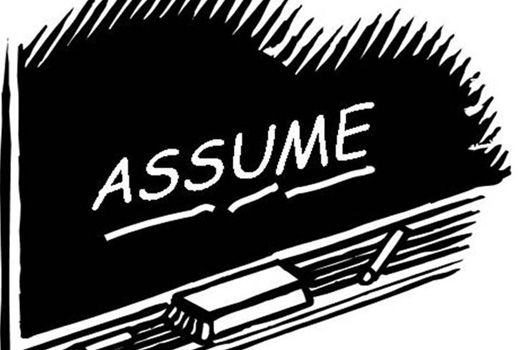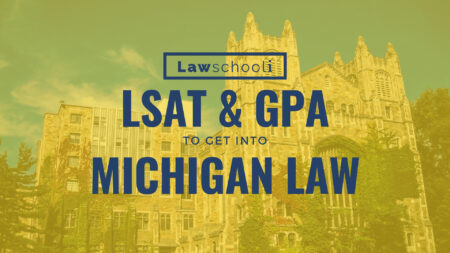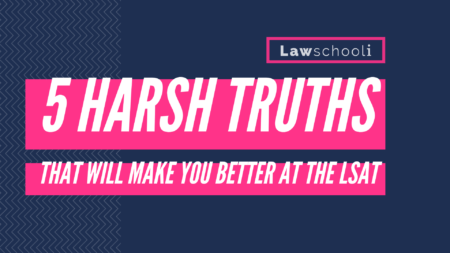LSAT necessary assumption questions are probably the logical reasoning (LR) question type most difficult to master. I found early in my practice that when I scored a practice section, at least one wrong answer was an assumption question. A ton of people report this same problem. Even when you have a thorough understanding of these questions, it’s easy to make mistakes.
Through a lot of effort, I learned to zero in on these questions and get to where I was nearly 100% accurate on them. I want to help you do the same. First, we’ll talk about general stuff you need to know about assumptions questions. Then we’ll give you a strategy for getting really good at them.

What is an LSAT Necessary Assumption?
When dealing with LSAT LR questions, you always want to be thinking in terms of premises and conclusions. Premises support a conclusion, forming an argument.
When you hear the word ‘assumption,’ I want you to think ‘premise.’ In an LSAT LR question, a necessary assumption is just another premise that supports the conclusion, only it goes unsaid. Commit this to memory: a necessary assumption is really just an unstated premise.
Now to talk about the “necessary” part. It’s called “necessary” because, without this premise, the argument will fail. I want to stress the “necessariness” as heavily as I can. The assumption is these questions are every bit as important to the argument being valid as anything that did get said. YOU NEED IT, OKAY. The argument won’t work if it’s not true (it wouldn’t be valid, in technical speak). You’ll see this on the examples we’ll give below, but first, let’s discuss what these questions actually look like on the test:
Structure of LSAT Necessary Assumption Questions
Necessary assumption questions will present an argument where some premise goes unstated. The correct answer choice is going to state that premise. Note that there may be one or more unstated premises. Luckily, there will be only one spelled out for you in the answer choices.
The important thing is that you be able to differentiate these from so-called “sufficient assumption” questions (also called “justify” questions). Those are different question types that we’ll discuss in our next LR post. Those present an assumption that, if true, would complete the argument. Still, there is a big difference: sufficient assumption question answers often give you way more information than is strictly necessary to conclude. If that’s confusing to you, don’t worry — just read the next LR post we’ll do (sign up on the sidebar, so you get it by email).
It’s easy to spot these questions because the prompt will say explicitly that the assumption is necessary. Let’s look at sample question prompts:
LSAT Necessary Assumption Question Sample Prompts:
Which one of the following is an assumption on which the author’s argument depends?
The argument depends on assuming which one of the following?
Which one of the following is an assumption required by the author’s argument.
Now you know how to spot these, and you know that a necessary assumption is an unstated premise that the argument absolutely relies on, let’s look at an example so you can see this in action. I’m going to give you a relatively easy one and a harder one:
LSAT Necessary Assumption Examples:
1) Several extensive recent surveys of the Yangtze river system revealed no trace of Baiji, a freshwater species of dolphin. Were there any dolphins present, the surveys would have certainly detected them. This is conclusive evidence that the Baiji must be extinct.
What is one necessary assumption here? How do you leap from the premise that there were no dolphins in the Yangtze to the conclusion that they are extinct, i.e., they don’t exist anywhere at all?
Necessary assumption: Baiji do not exist anywhere outside the Yangtze river system.
Note that it doesn’t matter exactly how it gets said. You have to be looking for some answer choice that communicates this assumption. However, necessary assumption answers are just going to have needed information, nothing extra and nothing more.
Okay, on to example 2:
2) Recently, the city of Houston decided to decrease the amount of time that all traffic lights remain yellow before turning to red, probably to increase revenue from traffic cameras installed at the lights. Insurance company statistics from the week following the change show a 20% spike in the number of auto-accidents at Houston intersections. This proves that shorter yellow lights can cause traffic accidents.
Alright. This is a classic type of assumption that might be really hard the first time you see it. The author argues that a cause (shorter yellow lights) affected (more traffic accidents at intersections). Well, for that to be true, there needs to be a connection between the yellow light timing and the spike in accident claims. What is an assumption on which the argument relies?
Necessary assumption: At least some of the additional accidents occurred at intersections with traffic lights.
If that weren’t true, then their argument would totally fall apart. Make it not true so you can see this: None of the additional accidents occurred at intersections with traffic lights. There would be then no evidence that the shorter lights can indeed increase traffic accidents. That would mean a dead argument. Something else must be explaining the spike in accidents like maybe there was an ice storm that week, and Houstonians can’t really drive under the best of conditions, let alone in an ice storm.
Thinking Like The LSAT
You may want to note that this one assumption we provided in example two is not the only assumption the author is making. They are also assuming that the lights were a contributing factor in the accidents at these intersections. However, that doesn’t make the assumption we stated any less necessary. After all, it’s impossible that the lights caused accidents somewhere else besides the intersections (that is the kind of common sense reasoning that you are allowed to make on the LSAT).
The LSAT is often not going to test more obvious assumptions where an argument relies on more than one unstated premise. For those used to technical logic speak, remember that just because an assumption is necessary doesn’t mean it is sufficient. Necessary assumption questions ask you to find one thing, one premise, that needs to be true for the argument to be valid.
Spotting assumptions can be tough. The truth is that your brain is probably so good at understanding unstated assumptions that you don’t often even notice them. If you read example two in real life, you’d probably just kind of take it for granted that the author did his research and the extra accidents were occurring at traffic lights. Same with the dolphin example. You might figure the scientist knows what he is talking about. Well, on the LSAT, you have to pull these assumptions out into the light and identify them.
If you think like you normally do, there is a big risk that you’ll miss the assumptions being made, making it harder to identify them and understand why they are necessary quickly.
It’s also really easy to get screwed up and miss assumptions by bringing your own real-world assumptions into the test. In real life, you know that most busy intersections have lights and that Houston has a ton of busy intersections, so it would seem logical that if there was a huge spike in accidents at intersections, then this is what caused it. However, on the LSAT, you can’t bring that outside knowledge in (did you know there are 10 cities and towns named Houston in the US? That question isn’t necessarily about Houston in Texas or even a real Houston). This might be Houston, Arkansas, which could have 3 red lights, yet 200 intersections with stop signs.
So yeah, these are assumption questions, but you are trying to identify the passage author’s assumptions, not make your own. Remember that. While you can make common sense assumptions on the LSAT (the sun is visible only during the day, water makes things wet, etc.), do not bring in your own assumptions about things that are not necessarily common knowledge or may not always be true.
Now all the general advice in the world won’t help you avoid all the traps that necessary assumption questions can set for you. Luckily, there is a good tool at your disposal to identify the necessary assumption. You may have already noticed us using it, but let’s spell it out now.
The LSAT Necessary Assumption Question Trick: Negating The Answer Choices
We’ve already said how the argument in an assumption question can’t live without the necessary assumption. That gives us a key strategy for solving these problems. You see what would happen to the argument if the assumption you are testing is not true. If the argument gets blown all to bits by negating an answer choice, then bam, you know that assumption was necessary. It’s the right answer.
This takes some mental gymnastics. Don’t worry; it hurt my head too the first time I heard it. Let’s repeat it:
If you negate an answer choice and the argument falls apart, that is the necessary assumption (the right answer!)
To see this in action, let’s do it again with an expanded example 1:
Scientist: several extensive recent surveys of the Yangtze river system revealed no trace of Baiji, a freshwater species of dolphin. Were there any dolphins present, the surveys would have certainly detected them. This is conclusive evidence that the Baiji must be extinct.
Which one of the following is an assumption on which the author’s argument depends?
(A) Every naturalist working in the Yangtze river has searched for the Baiji exhaustively for years now.
(B) Baiji could not survive the large scale dredging projects that have occurred on the parts of the river they inhabit.
(C) The recent surveys checked the entirety of the Baiji’s historical range.
(D) Baiji do not exist anywhere outside the Yangtze river system.
(E) There have been no recent reports of Baiji by local fisherman working on the Yangtze.
Okay, those are our answer choices. Let’s go through and negate them. To negate a statement, you make it untrue. It can take a little work to get good at that, but we’ll give you resources to practice. Usually, just adding “not” works (or getting rid of the “not” if it’s already negative).
Answer choice (A), “Every naturalist working in the Yangtze river has searched for the Baiji exhaustively for years now,” becomes “Not Every naturalist working in the Yangtze river has searched for the Baiji exhaustively for years now.” Does that destroy the argument? Not at all. Who cares about these naturalists? All that matters is that the recent surveys would be enough to determine that there were Baiji there or not. This isn’t our answer.
Answer choice (B), “Baiji could not survive the large scale dredging projects that have occurred on the parts of the river they inhabit,” becomes “Baiji could survive the large scale dredging projects that have occurred on the parts of the river they inhabit.” Again, this doesn’t destroy the argument. Just because they could survive, it doesn’t mean they did. (Answer choice B, by the way, could be correct if this was a sufficient assumption question, but it’s not.)
Answer choice (C), “The recent surveys checked the entirety of the Baiji’s historical range,” becomes “The recent surveys did not check the entirety of the Baiji’s historical range.” This is a tempting answer choice because it looks damaging to the argument that scientists didn’t check everywhere. Still, it doesn’t destroy the argument. They may not have looked at certain areas where Baiji used to live because it’s known absolutely that they can’t live in those parts now. Maybe there is a dam or something. If you can imagine any reason why the argument can survive without a premise, it’s not the right answer.
Answer choice (D), “Baiji do not exist anywhere outside the Yangtze river system,” becomes, “Baiji exist outside of the Yangtze river system. BAM! The argument is completely destroyed. You can no longer conclude that Baiji is extinct based on these surveys because there are Baiji elsewhere that we haven’t looked at. This is our answer. See how that worked?
Answer choice (E), “There have been no recent reports of Baiji by local fisherman working on the Yangtze,” becomes “There have been recent reports of Baiji by local fisherman working on the Yangtze.” Again, it doesn’t destroy the argument. Maybe the local fisherman wouldn’t know a Baiji if came up and punched them in the face, so what they did or didn’t see doesn’t matter.
There, now you’ve seen how to negate the answer choices. It’s basically a foolproof strategy for finding the answer. There’s one big problem. If you did all this work on each assumption question, you would have 10 minutes to do the other 23 LR questions. We can’t have that. Let’s talk about how actually to use this.
Actually Mastering LSAT Necessary Assumption Questions

Okay, since you can’t write out the negation for every assumption question answer choice when you are doing the actual LSAT, what do you do? Follow these steps:
STEP 1 -Starting Out
When you are first learning these assumption questions, you will be doing them untimed. At this point, I want you to use the negation method on every answer choice for a little bit. This will get you used to it. Start out writing the negated form out if you must, but you may find quickly that you can do it in your head.
Take the negated answer choices and determine whether they do or don’t destroy the argument.
Step 2 – Getting Comfortable
If you keep practicing, at some point, you are going to start seeing right away how some answer choices do not work (they aren’t necessary assumptions). Look back at answer choices (A) and (B) in our example. Pretty ridiculous, right? I bet you didn’t need to consciously negate the answers to figure out that those weren’t necessary assumptions.
At this point, you can start whittling down on the number of answer choices you test out. This might happen quickly, or it might happen slowly, but it will happen.
Step 3 – Mastery
When it gets so that you are only really taking a hard look at a couple of answer choices, you can start doing these questions timed. At this point, you should only use the negation strategy consciously on answers that are difficult to eliminate (or on the one that looks like the right answer to verify if it is).
It really is that easy. Trust me; if you start slowly and negate a ton of answer choices to get good at the technique, you’ll find that these questions aren’t even scary anymore. In fact, they might start to seem like the only question type that you can feel 100% confident about the answer!
You also may find that it is easy to do the process in your head rather than write anything down. This can shave off a little time, and anything that saves time on the LSAT is a good thing.
Additional LSAT Necessary Assumption Question Practice Resources
Obviously, you can go through your actual LSAT preptests and pull out assumption questions for practice. Use early preptests so you can save later ones for doing simulated practice tests.
It can also be beneficial to see how another pro handles these. For that, the best resource is The Logical Reasoning Encylopedia By Nathan Fox. He brings you through many of these (and other question types) in plain English, no BS fashion. Doing the problems with that as a guide will get you to a 100% comfort level.
Other than that, study hard and let us know if you are hitting any snags. We are always here to help!
This lesson is excerpted from our Mastermind Study Group. If you want to join, here’s how it works. You self-study (cheap!), but we are there to guide you every step of the way with premium lessons and coaching. Access us through the private forum or during live office hours. Join HERE.
LSAT Logical Reasoning Lessons





6 Comments
Retaking my LSATs in January and was like oh wow, NEGATION, like a light bulb went off in my head, thanks so much for this article will be coming back to review to master LR
Hi, thank you for this article! I think it’s incredibly helpful. However, I am confused about the second traffic lights example. Why isn’t “traffic lights are a contributing factor in the additional accidents” a prephrase you could do? Negated, “traffic lights are not a contributing factor in the additional accidents” seems to attack the argument.
I know you say that “After all, it’s impossible that the lights caused accidents somewhere else besides the intersections (that is the kind of common sense reasoning that you are allowed to make on the LSAT).” but I am still very confused by this.
Thank you in advance!
I love you guys<333
Wow! This article helped me understand how to attack assumption questions better than any of the 3 books that I have read. Thank you for this post!
Hi Evan and Josh,
Thanks for all your great articles. I have found them to be quite helpful so far.
I have purchased the Bibles per your advice, but was wondering is it necessary to buy the workbooks? Did you both use them? Would I be OK sticking with PrepTest sections?
Thanks!
Thanks for the piece!!